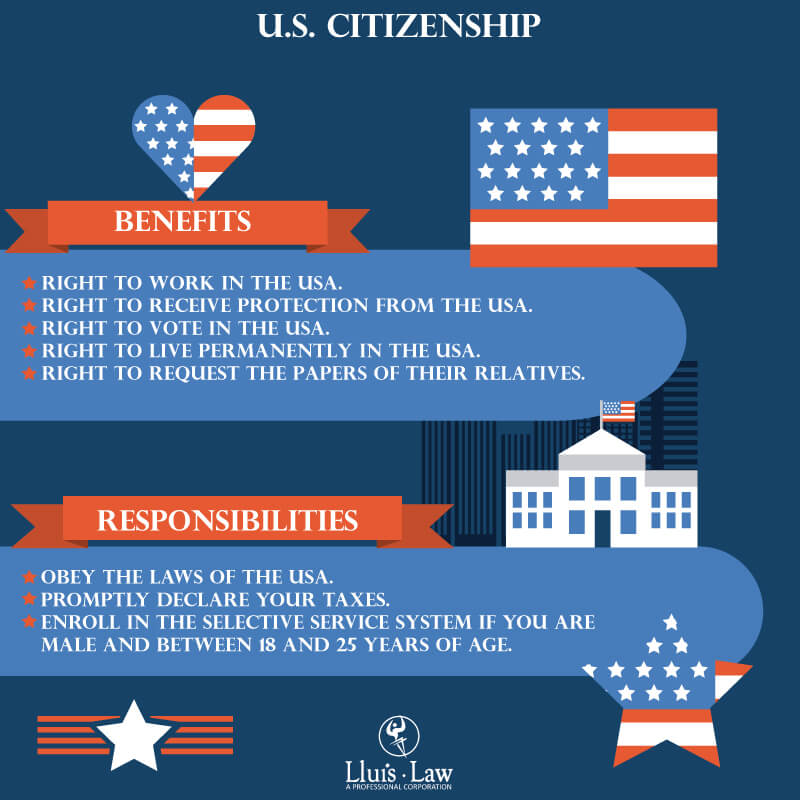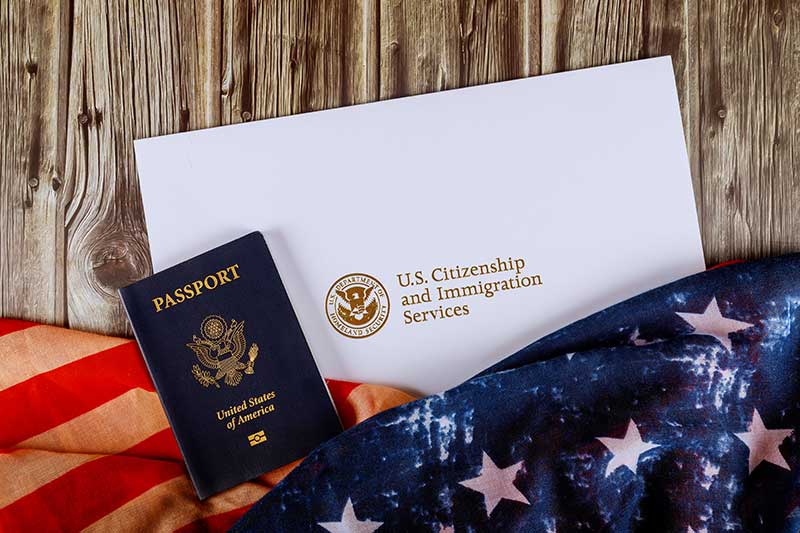For Green Card holders, knowing how to become a U.S. citizen is the final step to long-term stability in the United States. In general, the naturalization process requires you to:
- Meet the required years of permanent residence (5 years with a Green Card, or 3 if married to a U.S. citizen);
- File Form N-400 with USCIS and attend the biometrics appointment;
- Pass the naturalization interview and tests (with possible age/disability exemptions); and
- Take the Oath of Allegiance, at which point you officially become a U.S. citizen.
Citizenship can also be obtained through other avenues recognized by law, such as birth in the U.S. or its territories, derivation or acquisition through U.S. citizen parents, marriage to a U.S. citizen, or qualifying military service.
This updated guide covers the requirements to become a U.S. citizen, the costs and processing times, the test exemptions, real-life benefits, and common mistakes, plus practical examples to help you move forward confidently.
LATINOS WITH OVER 60 YEARS EXPERIENCE
Tell Us Your Case
Table of Contents
Step-by-step guide on how to become a U.S. citizen in 2025
The most common path to citizenship is naturalization. USCIS requires applicants to follow several steps in order:
- Check whether you truly need to apply.
- Confirm you meet the eligibility requirements.
- Only then, start the process by filing Form N-400.
Each stage is critical to avoid denials or delays.
If you’re wondering how to become a U.S. citizen, these first two steps help ensure you don’t start an unnecessary application.

1. Check whether you are already a U.S. citizen
Before you begin, confirm whether you even need to apply. Many people discover they are already U.S. citizens automatically and don’t need to complete naturalization.
Situations where citizenship is automatic:
- Birth in any of the 50 states, Washington D.C., or in certain U.S. territories such as:
- Puerto Rico;
- Guam;
- U.S. Virgin Islands; or
- Northern Mariana Islands.
- Being the child of at least one U.S. citizen at the time of birth, even if born abroad, as long as the Department of State’s residence requirements are met.
- Being adopted by U.S. citizens, if the adoption was completed before age 18 and the child resided in the U.S. as a lawful permanent resident.
- Being a lawful permanent resident under 18 and living in the U.S. in the custody of a parent who naturalized before the child turned 18.
How to verify it:
- Check documents such as a U.S. birth certificate, Consular Report of Birth Abroad (CRBA), or a Certificate of Citizenship.
- If unsure, you may file Form N-600 with USCIS to obtain official confirmation.
2. Confirm your eligibility for naturalization
If you confirm you are not already a citizen, the next step is to verify you meet the requirements for U.S. citizenship. You may qualify if any of the following apply:
- You are 18 or older and have been a lawful permanent resident for 5 continuous years.
- You have 3 years of continuous residence as a lawful permanent resident while married to and living with a U.S. citizen for that period.
- You have performed honorable service in the U.S. Armed Forces.
Additional USCIS requirements:
- Continuous residence and physical presence in the U.S. during the required period (30 months for the 5-year rule / 18 months for the 3-year marriage rule).
- Living for at least 3 months in the state or USCIS district where you file.
- Good moral character, with no serious criminal record or immigration fraud.
- Basic English and civics knowledge, unless you qualify for an age or disability exemption.
Many denials happen because Form N-400 is filed without meeting all the requirements.
Extended trips abroad or criminal issues can disrupt continuous residence and lead to denials.

To avoid this, it’s key to understand which criminal bars to citizenship can affect your case and how to address them with legal counsel.
3. Complete and file Form N-400
Form N-400 (Application for Naturalization) is the core of the process and can be filed in two ways. Filling it out correctly is essential to understand how to become a U.S. citizen without delays or Requests for Evidence (RFEs).
- Online: Create an account at my.uscis.gov. This is the recommended option because you can upload documents, pay securely, and receive electronic updates. (If requesting a fee waiver or reduction, you must file by paper.)
- By mail: Send the form and required documents to the Lockbox address for your state. Even if you mail it, it’s wise to create an online account to track your case.
Make sure all information matches official records. Errors in dates, addresses, or background details can trigger Requests for Evidence (RFEs) or even denials.
Basic documents commonly filed with the form:
- Copy of your Green Card (front and back).
- Proof of marital status (marriage, divorce, annulment, or death certificate).
- Travel history outside the U.S. during the last five years (three years if applying under the marriage rule).
- Evidence of federal tax filings (such as IRS transcripts).
- Proof of military service, if applicable.
- Any court records, birth certificates, or other evidence USCIS requests.
Tip: Before filing, make sure you are using the most current version on the official USCIS website. Outdated or unsigned forms are rejected automatically.
Practical example: Many people ask, “how can I become a U.S. citizen?” The safest and fastest way to avoid rejections is to file the N-400 online, as the system validates the current version and reduces payment errors.
4. Fees and fee waivers
In 2025, N-400 fees are:
- $710 if filing online.
- $760 if filing by paper.
The biometrics appointment is included in both fees.
Waivers and reductions:
- Military members on active duty and veterans are fee-exempt.
- Low-income applicants may request a full or partial waiver by filing Form I-912 (full waiver) or Form I-942 (partial reduction).
Accepted payments:
- Credit card;
- Debit card;
- Check or money order.
Common payment mistakes:
- Sending checks payable to the wrong entity.
- Using outdated forms to request waivers.
- Failing to attach sufficient proof of low income, which leads to denial of the benefit.
Practical tip: Some immigrants first pursue adjustment of status before naturalizing. That process makes you a lawful permanent resident and, after the legal waiting period, lets you take the next step toward citizenship.
5. Biometrics appointment
After accepting your application, USCIS will send a notice for your biometrics appointment. At this stage, they take your fingerprints, photo, and signature to verify identity and background.
Key points:
- USCIS sends the appointment by mail (Form I-797C) with date, time, and location.
- It’s typically held at a nearby Application Support Center (ASC).
- The process is brief (10–15 minutes) and does not include an interview.
Bring these documents:
- The official appointment notice.
- Your original Green Card.
- Photo ID (driver’s license or valid passport).
Tip: If you can’t attend on the scheduled date, request a reschedule immediately. Skipping the appointment without notice can delay your case for months.
6. Naturalization interview and tests
The interview is the heart of the process. A USCIS officer will review your application and confirm you meet the requirements for U.S. citizenship. During the appointment, three main evaluations occur:
Background and document review:
- Verification of travel history, employment, marital status, and tax compliance.
- Confirmation that there are no serious criminal records or immigration fraud.
English test:
- Assesses basic reading, writing, and conversation.
- Exemptions exist for age or disability (via Form N-648 or the 50/20 and 55/15 rules).
Civics test:
- Evaluates knowledge of U.S. history and government.
- As of October 2025, USCIS applies the new version of the test with 20 multiple-choice questions; you must answer at least 12 correctly.
- Applicants 65 or older with 20 years of lawful permanent residence have a simplified version with easier questions.
Sample civics questions
- What is the supreme law of the land?
- In what month do we vote for President?
- Name one branch or part of the government.

Tip: Bring all originals and copies, even if you already submitted them, to avoid delays if the officer needs to verify something. Also review guidance on how to dress for the citizenship interview to make a strong impression.
Some immigrants reach citizenship after first obtaining humanitarian protection. If that’s your situation, remember that asylum in the U.S. can lead to lawful permanent residence and, later, naturalization.
7. USCIS decision on your application
After the interview, USCIS may approve, continue (postpone), or deny your case:
- Approved: Your Oath ceremony will be scheduled.
- Continued: USCIS may request more evidence (RFE/NOID) or schedule a retest (usually within 60–90 days). This is not a denial.
- Denied: You may appeal with Form N-336 within 30 days or file a new N-400 once you meet the requirements. If the N-336 is denied, you can seek federal court review.
Generally, a denial does not cancel your Green Card. But if the reason involves fraud or crimes, USCIS may initiate proceedings. Seek legal advice before appealing or refiling.
Practical tip: Keep copies of everything you submit to USCIS; appeals often require the same evidence. In some cases, if a denial relates to serious background or immigration issues, you might need to explore options like cancellation of removal.
8. Oath of Allegiance
You do not become a citizen until you take the Oath of Allegiance at an official ceremony.
Key points:
- It may occur the same day as your interview if USCIS approves your case immediately.
- In most cases, the ceremony is scheduled a few weeks later.
- During the event, you will surrender your Green Card and complete a brief final questionnaire to confirm no legal changes occurred.
- At the end, you receive your Certificate of Naturalization, the official proof of citizenship.
Tip: Keep several certified copies of your Certificate of Naturalization; you will need it for a U.S. passport or to sponsor family.
9. Rights and responsibilities as a citizen

Becoming a U.S. citizen brings exclusive rights and also new responsibilities.
Main rights:
- Vote in federal, state, and local elections.
- Run for public office.
- Obtain a U.S. passport.
- Access federal jobs that require citizenship.
- Sponsor more relatives for lawful permanent residence.
- Broader access to certain federal benefits, subject to each program’s eligibility, with fewer limits than permanent residents face.
Main responsibilities:
- Obey federal, state, and local laws.
- Pay taxes on time.
- Serve on a jury when called.
- Defend the U.S. Constitution.
- Participate actively in civic life and democracy.
Practical tip: You gain these rights after you take the Oath of Allegiance and receive your Certificate of Naturalization.
10. Other ways to become a U.S. citizen
While naturalization is the most common route, it’s not the only one. The law recognizes several situations where a person may acquire citizenship automatically or on an expedited basis.
Clarification on marriage and naturalization
Being married to a U.S. citizen does not grant automatic citizenship, but it reduces to 3 years the residence requirement to qualify for naturalization—provided you live together and meet all other USCIS criteria.
To understand the evidence USCIS expects in these cases, review these marriage-based Green Card interview questions.
Military service and expedited path
Honorable service in the U.S. Armed Forces allows an expedited naturalization.
During periods of hostilities, USCIS can waive the prior residence requirement, so an eligible service member may become a U.S. citizen much faster than by the civilian route.
General eligibility requirements
To start the naturalization process, USCIS sets basic criteria that all applicants must meet.
The requirements to become a U.S. citizen are similar to prior years, though background checks and good moral character reviews are stricter.
Main requirements:
- Be at least 18 years old.
- Have been a lawful permanent resident for 5 years (or 3 years if married to and living with a U.S. citizen).
- Maintain continuous residence and physical presence in the U.S. during that period.
- Show good moral character (no serious crimes or immigration fraud).
- Demonstrate basic English ability (reading, writing, and speaking).
- Pass the civics test, with legal exceptions as applicable.
Practical example: If you apply under the 5-year rule, you must have been physically in the U.S. for at least 30 months during those five years. Someone who traveled abroad for 190 days total across several trips may still qualify if they spent more than 30 months inside the country.
Warning: Even seemingly minor issues like not filing taxes or long trips without proof of ties to the U.S. can interrupt continuous residence and delay eligibility.
Special rules for military applicants
Members of the U.S. Armed Forces enjoy unique conditions when applying for U.S. citizenship.
Main advantages:
- Expedited naturalization: Eligible after just 1 year of honorable service, without meeting the usual 3- or 5-year civilian rules (INA § 328).
- Wartime naturalization: Any service member during a designated period of hostilities may naturalize regardless of residence or physical presence time (INA § 329).
- Fee exemption: Exempt from paying the $760 N-400 fee and biometrics fee.
Additional documentation:
- Active-duty applicants must include Form N-426 (Request for Certification of Military or Naval Service), signed by an authorized officer.
- Veterans must attach Form DD-214 showing an honorable discharge.
Online filing: USCIS allows military members and veterans to file the N-400 digitally, speeding up the process.
Practical example: A lawful permanent resident with just 14 months of active-duty service during wartime could naturalize immediately, while a civilian in the same situation would have to wait years.
Note: Applicants with a dishonorable discharge or serious offenses may be ineligible. Both military members and veterans can apply for citizenship inside or outside the U.S. if they meet the honorable service requirements.
Required documentation to become a U.S. citizen

Gathering the correct documents is essential for naturalization. USCIS enforces strict requirements, and any omission can delay your case for months or even cause a denial.
Core required documents
- Copy of your Green Card (front and back).
- Filing fee: $710 if filing online, or $760 by paper.
- If requesting a fee waiver or reduction (I-912 or I-942), you must file by paper.
- Valid photo ID (passport, driver’s license, state ID, or military ID).
- Passport-style photos only if you file from outside the U.S.
Civil and family documents
- Certificates of marriage, divorce, annulment, or death, as applicable.
- Documents proving any legal name changes.
- Evidence of a bona fide marriage if applying under the 3-year rule (joint bills, bank accounts, leases, children in common).
Travel and residence documents
- Record of entries and exits from the U.S. in the last 5 years.
- Evidence of continuous residence, such as leases, utility bills, bank statements, or tax returns.
Special documents by case
- Military service: Form N-426 (active duty) or DD-214 (veterans) as proof of honorable service.
- Medical disability: Form N-648, signed by an authorized physician.
- Fee reduction or waiver: proof of income, means-tested benefits, or financial hardship.
- (Optional) Form G-28 if an accredited attorney represents you.
Practical example: If you were outside the U.S. for 7 months due to family reasons, submit strong evidence that you maintained ties to the U.S. (lease, tax filings, active employment). Such proof can be decisive so USCIS doesn’t find a break in continuous residence.
Costs and processing times in 2025
One of the biggest concerns is how to become a U.S. citizen fast. USCIS updates fees and processing times depending on office workload.
Knowing current fees and timelines helps you plan how to become a U.S. citizen with fewer surprises.
Official costs:
- Form N-400: $710 online / $760 by paper.
- Biometrics: included in the fee at no extra cost.
- Waivers and reductions: available for low-income applicants (I-912 for a full waiver / I-942 for a partial reduction).
- Military: exempt from the naturalization fee.
Average total timeline:
From filing the N-400 to the Oath ceremony typically ranges from 6 to 10 months, depending on volume and your local USCIS office.
Large offices like Los Angeles or Miami may take longer, while smaller ones can be under 6 months.
Comparison table: costs and timing
| Item | Official cost | Exceptions / reductions | Estimated time |
| Form N-400 | $710 online / $760 paper | Free for military; partial reduction (I-942) or full waiver (I-912) | 6–10 months |
| Biometrics | Included | N/A | 2–4 weeks after filing |
| Interview & tests | No extra cost | N/A | 3–6 months after biometrics |
| Oath ceremony | No extra cost | N/A | 1–2 months after approved interview |
Mini timeline of the naturalization process:
- Day 0: File Form N-400 (process starts).
- 2–4 weeks: Biometrics (fingerprints, photo, signature).
- 3–6 months: Interview and English/civics testing.
- 1–2 months: Oath ceremony and issuance of the Certificate of Naturalization.
Check current timelines on the official portal: Processing Times – USCIS. You can also review fee information in the Federal Register, where official updates are published.
The U.S. citizenship test and exemptions
The naturalization test is one of the stages that most concerns applicants who meet the requirements for U.S. citizenship.
USCIS evaluates two areas: English and civics, measuring communication skills and knowledge of U.S. history and government.
Preparing for both is crucial to succeed at how to become a U.S. citizen on the first try.
English test (summary)
Assesses reading, writing, and basic conversation. Exemptions exist based on age or years as an LPR, and for qualifying disabilities documented on Form N-648.
Tip: Fluency isn’t required—only basic comprehension and communication. If language is a concern, see see our article “Can you become a US citizen without speaking English.“
Civics test (version effective October 20, 2025)
- Measures knowledge of U.S. history and government.
- 20 multiple-choice questions; you pass with 12 correct answers.
- Applicants 65+ with 20+ years as LPRs have a simplified version with easier questions.
Example: What is the supreme law of the land?
Practical tip: If you don’t pass on the first try, USCIS lets you retake the failed part within 60–90 days.
Test exemptions
The law provides cases where the English test is not required and even allows a simplified civics exam:
- 50/20 rule: Age 50+ and 20 years as an LPR → English exam waived; civics in your own language.
- 55/15 rule: Age 55+ and 15 years as an LPR → English exam waived; civics in your own language.
- 65/20 rule: Age 65+ and 20 years as an LPR → English exam waived and reduced civics test (easier questions).
- Medical disability: with Form N-648 signed by an authorized physician, possible waiver of English and/or civics.
Tip: USCIS rejects medical forms that are incomplete or improperly signed. Provide clear, detailed evidence.
Benefits of becoming a U.S. citizen

Once you naturalize and receive your Certificate of Naturalization, you gain rights and opportunities that lawful permanent residents do not have.
Top benefits:
- Voting rights: Participate in federal, state, and local elections.
- Access to government jobs: Many federal positions require citizenship.
- Protection from removal: U.S. citizens cannot be deported, except in rare denaturalization cases for fraud.
- Broader public benefits: Access to programs like Medicare/Medicaid and federal assistance without time limits applicable to LPRs.
- Expanded family sponsorship: You can petition parents, married children, and siblings.
- Automatic citizenship for minor children: If you naturalize before they turn 18 and they reside with you.
- U.S. passport: Visa-free travel to 180+ countries and access to consular assistance abroad.
Practical example: A lawful permanent resident who spends more than six months abroad can jeopardize LPR status. A U.S. citizen, however, may remain overseas without time limits.
Common mistakes that cause denials or delays
Even though the process seems straightforward, USCIS rejects many applications due to avoidable errors.
Frequent issues include:
- Using outdated forms or paying the fee incorrectly (wrong payee, incomplete payment, or missing fee waiver proof).
- Failing to file taxes or doing so incompletely, which can affect good moral character.
- Taking long trips (over 6 months) without strong evidence of continuous residence.
- Criminal history without legal guidance: even minor offenses can matter if rehabilitation is not shown.
- Interview errors: inconsistent answers or failing to bring originals can lead to continuances.
Practical tip: Receiving public benefits does not bar citizenship, but lying or hiding information to obtain benefits such as food stamps can harm USCIS’s good-moral-character assessment.
Which family members can a U.S. citizen sponsor?
One of the most valuable perks of U.S. citizenship is sponsoring a wider group of relatives, something lawful permanent residents cannot do.
Immigration law precisely defines whom a U.S. citizen may petition:
Immediate relatives (no visa backlog):
- Spouse.
- Unmarried children under 21.
- Parents (if the citizen is 21 or older).
Other relatives (subject to Visa Bulletin backlogs):
- Unmarried sons and daughters 21+ (Category F1).
- Married sons and daughters of any age (Category F3).
- Brothers and sisters (Category F4).
Practical example: A citizen can file the petition for their parents as a U.S. citizen, and as immediate relatives, the process isn’t quota-limited and often moves in months.
By contrast, a citizen can petition siblings, but it may take 10+ years, especially for high-demand countries like Mexico or the Philippines.
FAQs about how to become a U.S. citizen
What is naturalization?
Naturalization is the process by which a lawful permanent resident becomes a U.S. citizen after meeting the requirements set by immigration law.
Is dual citizenship allowed?
Yes. The U.S. permits dual citizenship, so you generally do not have to renounce your original nationality to naturalize.
Do I need a Green Card to become a citizen?
In most cases, yes. There are exceptions, for example, certain military members can apply directly even without completing five years of residence.
Can I travel while my citizenship application is pending?
Yes, provided you maintain continuous residence in the U.S. and do not remain abroad for more than six consecutive months.
What if I have a criminal record?
It depends on the offense. Some minor issues do not automatically bar naturalization, but serious crimes, immigration fraud, or domestic violence can block it. Consult an attorney before filing if you have any record.
How our attorneys can help you become a U.S. citizen
Taking the step to U.S. citizenship can change your life. Understanding how to become a U.S. citizen means meeting legal requirements, filing accurate forms, and passing the USCIS interview.
This opens rights such as voting, sponsoring relatives, and traveling with a U.S. passport.
Every case is unique, extended travel, records, or paperwork issues can complicate matters. At Lluis Law, our immigration lawyers in Los Angeles assess eligibility, prepare Form N-400, and represent you before USCIS.
Contact us today and take the final step with an experienced legal team.
LATINOS WITH OVER 60 YEARS EXPERIENCE
Tell Us Your Case



